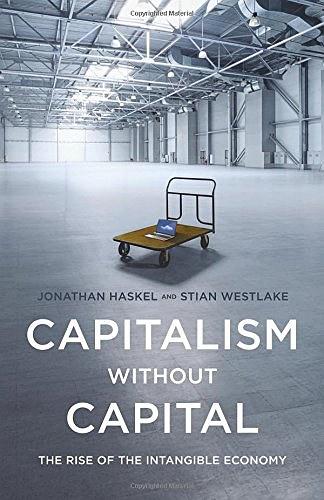
The first comprehensive account of the growing dominance of the intangible economy
Early in the twenty-first century, a quiet revolution occurred. For the first time, the major developed economies began to invest more in intangible assets, like design, branding, R&D, and software, than in tangible assets, like machinery, buildings, and computers. For all sorts of businesses, from tech firms and pharma companies to coffee shops and gyms, the ability to deploy assets that one can neither see nor touch is increasingly the main source of long-term success.
But this is not just a familiar story of the so-called new economy. Capitalism without Capital shows that the growing importance of intangible assets has also played a role in some of the big economic changes of the last decade. The rise of intangible investment is, Jonathan Haskel and Stian Westlake argue, an underappreciated cause of phenomena from economic inequality to stagnating productivity.
Haskel and Westlake bring together a decade of research on how to measure intangible investment and its impact on national accounts, showing the amount different countries invest in intangibles, how this has changed over time, and the latest thinking on how to assess this. They explore the unusual economic characteristics of intangible investment, and discuss how these features make an intangible-rich economy fundamentally different from one based on tangibles.
Capitalism without Capital concludes by presenting three possible scenarios for what the future of an intangible world might be like, and by outlining how managers, investors, and policymakers can exploit the characteristics of an intangible age to grow their businesses, portfolios, and economies.
1、追日是作者栎年创作的原创作品,下载链接均为网友上传的的网盘链接!
2、相识电子书提供优质免费的txt、pdf等下载链接,所有电子书均为完整版!
-
licheng47的评论当今世界经济有一个新的特点,那就是,很多优秀的创意脱离了实体形式,主要以无形资产的形式存在。书中说,在美国、英国和瑞典,对无形资产的投资已经超过了有形资产。市值在逼近一万亿美元的苹果公司,无形资产要比实物资产多得多。这是一个无形资产的时代。 无形资产有四个特性,分别是:可扩展性(一个人使用一项无形资产,并不妨碍另一个人继续使用);沉没性(不同于有形资产如土地或工厂,无形资产必须作为拥有者业务的一部分才有价值);溢出性(即便知识资产受到保护,投资一项创意的很多好处也可能落到模仿者和跟随者手中)和协...
-
winston的评论作者是自己得老师,就多说几句体外话。 有一次讨论得时候,就曾经讨论过西方国家的经济发展是不是低估了,尤其在无形资产对在经济中占有越来越重的比例的时候。而现在通用的GPD衡量的方式,也没有良好的体现无形经济的作用。希望他未来能把他新的研究,建立一种更好衡量的经济计算方式写到他新书里面。 另外,书里面最后两章,人力资本及人力资本所创造的无形资产对于新经济结构的影响,其实很值得大家深思。因为这所带来的,是能够开发和整合知识的个人,企业和组织,将会获得越来越大的优势,并且建立起强大的壁垒。而这个壁垒,就是制...
-
元非的评论有些地方算 speculative,不过肯定值五星了。
-
Jess的评论One of the most important books I read this year.
-
恶趣味多美的评论很规范的学术作品,条理清晰,内容充实。读起来十分舒服,读罢方才深切体会到GDP统计数字的indication的局限且“失真”,而面对无形资产的4s特点所导致其非常dynamic甚至有点玄妙以至于难以检验的现状,让人不禁期待这样的一个测量标准早日出来
-
宝宝TWO的评论Very very tedious. full of "analysis" but no point no conclusion, even no funny sentence.
-
小实的评论无形资产投资的特点、经济后果及政策应对。非常深刻的分析,有很多洞见。
-
本杰明的评论购买链接:https://item.taobao.com/item.htm?spm=0.7095261.0.0.39941debETEHbz&id=568888043949
-
夏日的末末茶的评论原版比翻译版好读。
-
方觉夏深的评论结构超清晰 观点的提出和层层推演在严肃学术的“self-esteem感”之外有友好和人文关怀 | 很喜欢文中作为补充介绍的boxes 比如“Box 4.1. Knowledge, Data, Information, and Ideas: Some Definitions” 真是超友好了